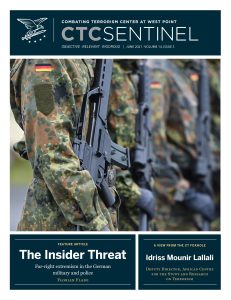From the Editor
“A series of extreme far-right cases among members of Germany’s military and police highlight the threat of the enemy within: radicalized extremists within security services, with access to weapons, training, and confidential information,” Florian Flade writes in this month’s feature article. According to Flade, “The specter of armed underground cells being trained by former or current members of the security services has been a wake-up call for authorities. New measures have already been implemented within Germany’s domestic and military intelligence agencies to more effectively root out enemies of the state wearing uniforms. Nevertheless, the threat will most likely persist in the coming years.” He adds that “with the United States and other countries also grappling with this problem set, it is vital to share lessons learned and best practices at the international level.”
This month’s interview is with Idriss Mounir Lallali, the Deputy Director and Acting (Interim) Director of the African Centre for the Study and Research on Terrorism (ACSRT), a structure of the African Union Commission (the secretariat of the African Union).
Alex Newhouse examines “the multi-node structure” of a global network of violent neo-fascist accelerationists seeking system collapse. He writes that “evidence from Atomwaffen’s development and collapse reveals that it was not the apex of a hierarchy of groups, but rather one node in a larger network of violent accelerationists. This network is built on membership fluidity, frequent communications, and a shared goal of social destruction. This framework is vital to understanding how and why action against individual groups is not sufficient, and why the threat from Atomwaffen has not faded in spite of its reported ‘collapse.’ The lesson to be drawn from the history of the Atomwaffen Division is that the current threat of neo-fascist accelerationism exists more in the evolution of the network as a whole, rather than in any one individual group.”
Peter Kirechu examines “Iran’s Currency Laundromats in the Emirates.” He writes that “Since 2014, the United States has sanctioned dozens of Iranian nationals and commercial entities for the illicit acquisition of U.S. and other foreign currencies. A close review of these designations reveals the organized character of Iran’s illicit currency laundering operations and the role of the Islamic Revolutionary Guard Corps (IRGC) in their orchestration. It also shows that Iran relies on a diverse network of illicit commercial entrepreneurs to covertly access foreign currencies abroad. These actors operate under the cover of legitimate commerce and exploit the vulnerabilities of regional economic centers—such as the United Arab Emirates—to provide covert financial resources to the Revolutionary Guards.”
Paul Cruickshank, Editor in Chief
 Skip to content
Skip to content

